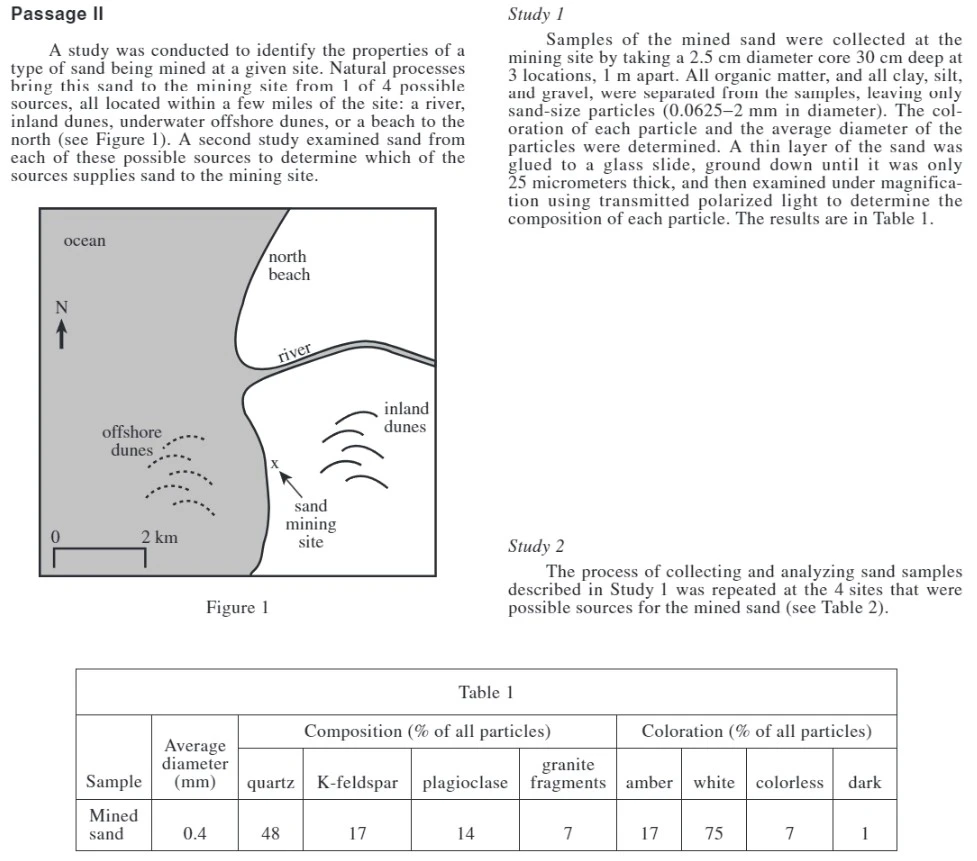Section: Science 0 Likes
Passage II - A study was conducted to identify the properties of a (September 2023 - G01)

Questions from Passafe II
8) How did the average particle diameter of river sandcompare to those of the other sands in Study 2? Riversand had an average particle diameter that was:
F. smaller than the average particle diameter of all of the other sands.
G. smaller than the average particle diameter of only some of the other sands.
H. the same as the average particle diameter of one of the other sands.
J. larger than the average particle diameter of all of the other sands.
9) If a minimum of 10% of the particles in a sand areamber-colored, the entire sand will appear reddish-brown. Which sand from the studies would NOTappear reddish-brown?
A. Mined sand.
B. River sandC.Underwater offshore dune sand.
D. North beach sand.
10) Which of the following statements best explains why the sum of the particle composition percents for any ofthe sands did not equal 100%?
F. The number of particles composed of quartz was actually much lower than measured.
G. The number of particles that were granite frag-ments was actually much lower than measured.
H. Some particles were composed of materials other than quartz, K-feldspar, plagioclase, or granite fragments.
J. All of the particles were composed of either quartz, K-feldspar, plagioclase, or granite fragments.
11) In Study 2, based on the average particle diameter fornorth beach sand, a north beach sand sample mostlikely contained:
A. only particles that were 0.3 mm in diameter.
B. only particles that were larger than 0.3 mm indiameter.
C. only particles that were smaller than 0.3 mm indiameter.
D. some particles that were larger than 0.3 mm india meter and some particles that were smaller than0.3 mm in diameter.
12) The description in Study 1 of the methods used to pre-pare the sand sample for viewing under magnificationindicates that intacts and particles are most likely too:
F. heavy to be fixed to a glass slide.
G. large to be fixed to a glass slide.
H. thick to allow light to pass through.
J. thin to allow light to pass through.
13) Based on the results of Studies 1 and 2, sand is mostlikely brought to the mining site from the:
A. river.
B. underwater offshore dunes.
C. inland dunes.
D. north beach.
14) If sand is being supplied to the mining site from thein land dunes, one or both of which 2 erosion processesare most likely capable of moving the sand directly from the inland dunes to the mining site?
F. Ocean waves and wind.
G. Ocean waves and glaciers.
H. Running water and wind.
J. Running water and glaciers.
Solution
Correct answer: 8 - F
9 - B
10 - H
11 - D
12 - H
13 - B
14 - H.
8 - Answer: F. The image text indicates that the average particle diameter of the river sand was smaller than the average particle diameter of all the other sands analyzed in Study 2. (text passage Study 2)
9 - Answer: B. River sand (text passage Study 1, Table 1)
10 - Answer: H. Some particles were composed of materials other than quartz, K-feldspar, plagioclase, or granite fragments. (text passage Study 1, Table 1)
11 - Answer: D. some particles that were larger than 0.3 mm in diameter and some particles that were smaller than 0.3 mm in diameter. (text passage Study 2, Table 2)
12 - Answer: H. The description of the methods used to prepare the sand sample for viewing under magnification in Study 1 suggests that the sand grains are probably fine enough to allow light to pass through. (text passage Study 1)
13 - Answer: B. Although the text of the images does not explicitly indicate the origin of the sand used in the mine, there are clues to suggest that it comes from offshore submarine dunes.
14 - Answer: H. The text of Study 1 indicates that flowing water and wind are the two most likely erosion processes to move sand directly from the inland dunes to the mine site. (text passage Study 1)
Exam Edition: September 2023 - G01
Exam Year: 2023
Related topics: Geology, Materials Science